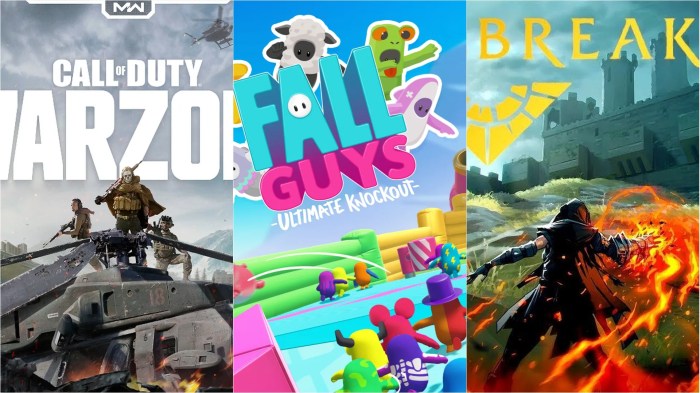
Embark on a journey into the vibrant world of online multiplayer gaming, where the thrill of competition and camaraderie intertwines. This exploration delves into the criteria defining “top” multiplayer games, examining factors such as player base size, longevity, critical reception, and innovative gameplay mechanics. We’ll explore diverse genres, from the strategic depth of MOBAs to the cooperative challenges of MMOs, highlighting games specifically designed to facilitate interactions with strangers.
The discussion will also address the inherent challenges – such as toxicity and communication barriers – and strategies for fostering positive online experiences.
We will examine how game mechanics, from in-game communication systems to shared objectives, encourage interaction and cooperation. A historical overview will trace the evolution of online gaming, showcasing key milestones and technological advancements that have shaped the social dynamics of online play. Finally, we will speculate on future trends and the impact of emerging technologies like VR/AR and AI on the experience of playing with strangers.
The Evolution of Online Gaming

Online multiplayer gaming has undergone a dramatic transformation since its inception, evolving from text-based adventures to the immersive, visually stunning experiences we enjoy today. This evolution is marked by significant technological advancements and a constantly shifting social landscape, shaping how players interact and the very nature of online communities.The journey of online multiplayer gaming is a fascinating study of technological innovation and its impact on human interaction.
Early forms relied heavily on dial-up connections and rudimentary text interfaces, limiting the possibilities for real-time interaction and visual fidelity. The subsequent rise of broadband internet and increasingly powerful hardware significantly expanded the potential for richer, more complex gaming experiences. This technological progress has been intrinsically linked to changes in social dynamics, influencing how players communicate, collaborate, and compete.
Technological Advancements and Key Milestones
The development of online multiplayer gaming can be charted through several key technological advancements. Initially, text-based MUDs (Multi-User Dungeons) and MOOs (MUD, Object-Oriented) laid the foundation, allowing players to interact within a shared virtual world through text commands. The introduction of graphical user interfaces (GUIs) and graphical MUDs marked a significant leap forward, paving the way for more visually engaging experiences.
The rise of the internet protocol suite (TCP/IP) and the World Wide Web provided the infrastructure for widespread online connectivity, enabling the creation of massively multiplayer online games (MMOs) with thousands of concurrent players. Further breakthroughs, such as the development of dedicated game servers and client-server architectures, significantly improved the stability and performance of online games. Finally, the advent of high-speed internet and powerful gaming PCs and consoles allowed for the development of highly detailed and realistic online gaming environments.
Shifting Social Dynamics in Online Gaming
The social dynamics within online gaming communities have evolved considerably over time. Early online games often fostered a sense of close-knit community among players, often characterized by a high degree of cooperation and mutual support. As the scale and complexity of online games increased, so did the diversity of players and their motivations. The emergence of competitive gaming and esports introduced new forms of social interaction, with players forming teams, competing for prizes, and building reputations within their communities.
The rise of voice communication and streaming platforms has further transformed social dynamics, allowing players to communicate more directly and engage in a wider range of social activities. However, this increased interaction also brought challenges, including issues of toxicity, harassment, and the potential for social isolation.
Timeline of Key Features Enabling Interaction with Strangers
The ability to play with strangers has been a defining feature of online gaming, and its development can be mapped across several phases:
The following timeline highlights key developments:
| Year (Approximate) | Development | Impact on Playing with Strangers |
|---|---|---|
| 1970s-1980s | Text-based MUDs and MOOs | Established the foundational concept of shared virtual worlds accessible to multiple players simultaneously, facilitating interaction with unknown users through text. |
| 1990s | Graphical MUDs, early MMOs (e.g., Neverwinter Nights) | Introduced graphical interfaces, making interaction more intuitive and accessible, expanding the potential player base and interactions between strangers. |
| Late 1990s – 2000s | Rise of broadband internet, dedicated game servers, improved client-server architecture | Enabled larger-scale MMOs with thousands of concurrent players, fostering interactions among a significantly broader range of strangers. |
| 2000s – Present | Voice chat integration, matchmaking systems, social features within games | Enhanced communication and interaction, streamlining the process of finding and playing with strangers, and fostering more complex social dynamics within game communities. |
Future Trends in Online Multiplayer Gaming

The landscape of online multiplayer gaming is constantly evolving, driven by technological advancements and shifting player preferences. We can expect significant changes in the coming years, impacting how players interact with each other and the games themselves. These changes will be shaped by the integration of emerging technologies and a growing focus on fostering positive and inclusive online communities.The integration of virtual and augmented reality (VR/AR) will fundamentally alter the multiplayer experience.
Imagine immersive, shared virtual worlds where players can truly inhabit their avatars, interacting with each other in more realistic and engaging ways. AI will also play a significant role, potentially acting as dynamic game masters, creating personalized challenges, and even mediating conflicts between players.
The Impact of VR/AR and AI on Multiplayer Interactions
VR/AR technologies promise to revolutionize how strangers interact in online games. By creating more immersive and realistic environments, these technologies will enhance the sense of presence and connection between players. Imagine a collaborative puzzle game in VR where players must physically manipulate virtual objects to solve a problem together, fostering teamwork and communication in a tangible way. Similarly, AR could overlay game elements onto the real world, allowing strangers to participate in shared experiences within their own physical spaces.
AI can assist in this by dynamically adjusting the game’s difficulty based on the players’ skills and interactions, ensuring a balanced and enjoyable experience for everyone. AI could also act as a facilitator, suggesting cooperative activities or providing helpful hints to improve the overall gameplay experience. This technology could also help mitigate negative behaviors by identifying and addressing toxic interactions promptly and effectively.
A Hypothetical Future Online Game
Imagine “Harmony,” a future online game where players collaborate to build and maintain a vibrant virtual ecosystem. Players, represented by customizable avatars, choose roles such as architects, gardeners, or conservationists, each contributing to the overall health and prosperity of the virtual world. The game prioritizes cooperation and positive interactions through a reward system that incentivizes helpful behavior and teamwork.
Players earn points not only for completing individual tasks but also for assisting others, sharing resources, and resolving conflicts peacefully. AI plays a crucial role, acting as a benevolent guide and mediator, ensuring that the game environment remains supportive and inclusive. The focus is on shared achievement and fostering a sense of community among players, creating a positive and engaging experience even for those playing with complete strangers.
The world of online multiplayer gaming offers a unique social landscape, constantly evolving with technological advancements and shifting player preferences. While challenges like toxicity exist, the potential for forming communities, friendships, and even rivalries with strangers remains a significant draw. By understanding the factors contributing to a positive online experience and utilizing strategies to mitigate negative interactions, players can unlock the full potential of these virtual worlds, forging connections and creating lasting memories in the shared space of online play.
The future of online gaming promises even more immersive and interconnected experiences, further blurring the lines between the virtual and real worlds.
Essential Questionnaire
What are some tips for finding trustworthy players when playing with strangers?
Look for games with robust reporting systems and active communities. Observe player behavior in early game interactions before fully committing to a team. Consider joining established guilds or clans for a more structured and supportive environment.
How can I improve my communication skills while playing with strangers?
Use clear and concise language. Be respectful and patient. Utilize in-game communication tools effectively. Focus on collaborative strategies and avoid accusatory language. Learn basic phrases in other languages if playing with an international community.
What should I do if I encounter toxic players?
Utilize the game’s reporting system. Mute or block the player to avoid further interaction. Avoid engaging with toxic behavior; responding often escalates the situation. If the problem persists, contact the game’s support team.






